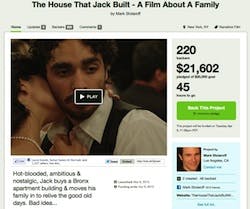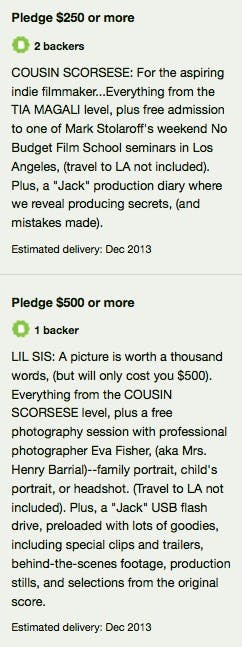Part I: 10 Tips to a Successful Crowdfunding Campaign

Part I: 10 Tips to a Successful Crowdfunding Campaign

As I wind down the Kickstarter campaign for my new film The House That Jack Built, the second successful campaign I've run, I'd like to share with you some insights gained from doing this a second time. Having also consulted on several campaigns, donating to over 70 Kickstarter/IndieGoGo campaigns, and visiting countless more, I can confidently stand behind these tips.
Completing the Kickstarter cycle once (for our successful campaign for Pig, which appeared in festivals all over the world, winning numerous awards) all the way through--predicting, planning, running the campaign, fulfilling the rewards, and nurturing the community--has given me new insight that I was able to use on this campaign. Now, I'm not going to tell you this Jack campaign was the greatest or most successful Kickstarter campaign ever posted--I mean Veronica Mars made $2 million in one day!--but considering what we had to work with, (our available time, our circle of influence, our personal networks, the kind of material we had, etc.), I'm happy with how the campaign turned out. Here's the link to the campaign for reference: https://kck.st/ZpIodv. And here now are 10 tips to help you with your next campaign:
 Kickstarter vs. IndieGoGo? Kickstarter! This is one of the first questions I get asked and my answer, though not fully informed, (I've never launched an IndieGoGo campaign), is an unqualified 'KICKSTARTER.' You could probably look at statistics somewhere that compare how much more money is raised for film projects on Kickstarter; I don't know all that. My recommendation comes from using Kickstarter as a Backer and as a Creator. I think the Kickstarter interface is miles ahead of IndieGoGo for both Backer and Creator; certainly for the Backer. I give to both types of projects and go through that purchase process all the time, and Kickstarter's is much better. The updates you receive from projects are better with Kickstarter, too. Having leaned on the Kickstarter platform this time for statistics and keeping track of things, I can tell you it's very well-designed and is constantly improving. Plus now they have a great iPhone app. But here's the biggest reason: you're going to get more "stranger dollars" on Kickstarter than on IndieGoGo. I can't verify that, of course, but I'm confident it's true. I ask each and every Backer I don't know how they heard about our campaign, and several folks this time found us through the platform--some on curated pages (more on this below), some on Kickstarter's recommendation pages, some using search tools. Kickstarter's dashboard also shows you this information. At least three backers found us after giving to Veronica Mars. IndieGoGo does not have Veronica Mars on their platform.
Kickstarter vs. IndieGoGo? Kickstarter! This is one of the first questions I get asked and my answer, though not fully informed, (I've never launched an IndieGoGo campaign), is an unqualified 'KICKSTARTER.' You could probably look at statistics somewhere that compare how much more money is raised for film projects on Kickstarter; I don't know all that. My recommendation comes from using Kickstarter as a Backer and as a Creator. I think the Kickstarter interface is miles ahead of IndieGoGo for both Backer and Creator; certainly for the Backer. I give to both types of projects and go through that purchase process all the time, and Kickstarter's is much better. The updates you receive from projects are better with Kickstarter, too. Having leaned on the Kickstarter platform this time for statistics and keeping track of things, I can tell you it's very well-designed and is constantly improving. Plus now they have a great iPhone app. But here's the biggest reason: you're going to get more "stranger dollars" on Kickstarter than on IndieGoGo. I can't verify that, of course, but I'm confident it's true. I ask each and every Backer I don't know how they heard about our campaign, and several folks this time found us through the platform--some on curated pages (more on this below), some on Kickstarter's recommendation pages, some using search tools. Kickstarter's dashboard also shows you this information. At least three backers found us after giving to Veronica Mars. IndieGoGo does not have Veronica Mars on their platform.- Launch Before or After Filming? Yes. Ok, sorry about the cheeky answer, but this one really depends. If you have some money to get started on your film, I like the idea of using Kickstarter for finishing funds, as I have done both times. If your story isn't easily explained or there isn't a strong reason for folks to want to give you money, or a way to connect people to the project, then waiting until after there is something to show helps. People will always respond to strong material--well-shot, well-acted, well-written material--no matter what the story or genre. If, however, you're making a documentary with a strong social cause, you don't need that footage to sell your project to friends and supporters of that cause. These kinds of projects do very well prior to filming. There is an important distinction, then, between the two types of projects. People like to feel they're helping in some way. If you implore people to give to the torture porn horror film you want to make, many are going to be turned off. But, if you shoot a very cool horror film that people can get a taste of while you're editing, they're going to want to be a part of it.
- Choose Your Goal Wisely. I swear, some people calculate how much money they need to shoot or finish and that's the amount they try to raise. NO! As you know, Kickstarter is all-or-nothing, (that's one of the reasons it works so well, that, and a time limit). But you have to look at your situation--the kind of project you have, the amount of help you have, the number of friends you have (with money), etc.--and figure out a reasonable and likely amount you can raise. There are two downsides to picking the wrong number. If you pick too low, then it will be hard to keep people motivated to continue pushing your campaign once you raise your goal, (that happened to us when we made our goal with 4 days left in the campaign). But that is preferable to not reaching your goal. Besides all the hard work you've now thrown down the drain, and the money you won't have to make your film, you've also just set a bad and potentially humiliating precedent for your film, (of course, there might be several valuable things to learn from an unsuccessful crowdfunding campaign--does anyone want to see this film? Are you talking about it correctly?). The perfect scenario is to choose something a bit out of reach, have someone standing by to help if you don't reach it, and then you can use the deadline to your advantage as you fight in the final hours to make your goal. I've seen projects rally in those last 48 hours and raise big money, in an effort to reach their goal. And remember, while many projects these days are raising 6 figures, they all have very specific reasons for being able to do so. You may not have those reasons. Raising $15,000, even $10,000 can be incredibly difficult.
 Video Recommendations. Like I've said many times in my classes, and it bears repeating, MAKE A VIDEO. There's nothing more damaging for a potential backer to realize than you don't give a shit about your own project. If that's so, why should they? So, you have to make one. There are some great, classic crowdfunding videos out there, (here's a recent favorite). Some go viral, which is the holy grail of crowdfunding videos. But those are hard to come up with and sometimes your project just doesn't lend itself to that kind of treatment, or maybe you're just not capable of coming up with the next great video meme. That's perfectly fine. A straight video (like mine) works perfectly well, even if it's not perfect. Mine is not, but it worked for us. Here's the thinking that went into our video. It should look as good as you can make it look without killing yourself or spending money. Ours looks, at best, ok; (moments of it look about as bad as video can look). It should sound great. Make sure you have a way to put a professional mic on your subjects, (a lav or a mic on a boom just out of frame). You should have the director (and/or others) talking directly to camera, directly to the potential backers. These videos work best when they're personal, honest, authentic and sincere. The "performance" doesn't have to be perfect as long as it's real. Having said that, though, a good performance goes a long way. It's REALLY hard to speak on camera like this; much harder than it looks. Henry in our video is pretty good, but this is after numerous takes and much cutting (cutaways/b-roll are crucial), and Henry is a professional actor. If you're on-camera person is not, rehearse. Work on it until they get good. We didn't have time to do that, but if we had, it would have helped. As I mentioned, have something to cut away to. If you've already shot your film, using your footage as b-roll is ideal and goes a very long way. But there are all kinds of things to cut away to. Look at what we used in the Jack video and the Pig video. And I am not an editor. I edited these in iMovie, so you don't have to spend money to get a decent video. The most important part of your video is to tell the story behind the story. You should have a good story behind the story, because fans, (and that's what you're trying to attract), respond to this. Sometimes that story is more interesting than the story in your film. Is my video too long? Absolutely! Kickstarter tells me that only 26% of people who have viewed the video have watched the whole thing. Then what was I doing? I was thinking about constituencies. Who is going to help spread the word about my film. After we tell what the film is about and what the story behind the story is, we then give shout-outs to various groups who I'm hoping will spread the word about the campaign. It's like advertising time.
Video Recommendations. Like I've said many times in my classes, and it bears repeating, MAKE A VIDEO. There's nothing more damaging for a potential backer to realize than you don't give a shit about your own project. If that's so, why should they? So, you have to make one. There are some great, classic crowdfunding videos out there, (here's a recent favorite). Some go viral, which is the holy grail of crowdfunding videos. But those are hard to come up with and sometimes your project just doesn't lend itself to that kind of treatment, or maybe you're just not capable of coming up with the next great video meme. That's perfectly fine. A straight video (like mine) works perfectly well, even if it's not perfect. Mine is not, but it worked for us. Here's the thinking that went into our video. It should look as good as you can make it look without killing yourself or spending money. Ours looks, at best, ok; (moments of it look about as bad as video can look). It should sound great. Make sure you have a way to put a professional mic on your subjects, (a lav or a mic on a boom just out of frame). You should have the director (and/or others) talking directly to camera, directly to the potential backers. These videos work best when they're personal, honest, authentic and sincere. The "performance" doesn't have to be perfect as long as it's real. Having said that, though, a good performance goes a long way. It's REALLY hard to speak on camera like this; much harder than it looks. Henry in our video is pretty good, but this is after numerous takes and much cutting (cutaways/b-roll are crucial), and Henry is a professional actor. If you're on-camera person is not, rehearse. Work on it until they get good. We didn't have time to do that, but if we had, it would have helped. As I mentioned, have something to cut away to. If you've already shot your film, using your footage as b-roll is ideal and goes a very long way. But there are all kinds of things to cut away to. Look at what we used in the Jack video and the Pig video. And I am not an editor. I edited these in iMovie, so you don't have to spend money to get a decent video. The most important part of your video is to tell the story behind the story. You should have a good story behind the story, because fans, (and that's what you're trying to attract), respond to this. Sometimes that story is more interesting than the story in your film. Is my video too long? Absolutely! Kickstarter tells me that only 26% of people who have viewed the video have watched the whole thing. Then what was I doing? I was thinking about constituencies. Who is going to help spread the word about my film. After we tell what the film is about and what the story behind the story is, we then give shout-outs to various groups who I'm hoping will spread the word about the campaign. It's like advertising time.- Text Recommendations. The conventional wisdom is that people look at your video first, then maybe your text. So, the assumption might be to not put much effort into your text. NO! Again, it's all about looking like you give a shit, in every aspect. Your text, even if no one reads it, should enhance and expand upon the information you give in your video. This is also the place for information that you didn't have time to include in your video. It doesn't have to be overly long, but it should be compelling and attractive. Use graphics (you can add pictures and video, and you can add pictures that look like text, like this campaign did.) You can see from mine what information I thought was important: what the film is about, the story behind the film; the team members; what the funds will be used for; how Kickstarter works; etc. Your text should include all your links and instructions on spreading the word, and I like highlighting some of your rewards, especially if you need more room to explain some of them. You can update the text throughout the campaign, but once the campaign is over, it's locked, so make sure to make last-minute adjustments right before then. These pages stay on the platform forever, and people will continue to discover your project even after the campaign is over. Give them instructions on how they can support you outside of Kickstarter.
The Art and Science of No-Budget Filmmaking runs again on May 11th-12th from 9AM-6PM both days. Stage 32 members $50 off the price of the class.
Specifically designed for no-budget filmmakers who are ready to finance their own projects, the lessons, tools, and techniques gained will maximize limited resources and minimize critical errors that can doom otherwise worthy projects. Producer Mark Stolaroff - former principal of IFC's Next Wave Films - and guest experts teach the specific methods, models and priorities unique to micro-budget filmmaking, whether the budget is $200,000 or $200, in this in-depth, one-of-a-kind class. Attendees will walk away with powerful ideas that they can use immediately, saving them time and money. These cutting edge techniques can NOT be found in a book, at film school, or in other film classes.
For more information and to sign up for the class, please visit The Art and Science of No-Budget Filmmaking.
Part II of "10 Tips to a Successful Crowdfunding Campaign" will run this Thursday.
Mark is available for questions and remarks in the comments section below.
About the Author

Mark Stolaroff
Producer
Mark Stolaroff is an independent producer and a founding partner of Antic Pictures, an LA-based production company producing a slate of low budget, high quality digital features. Stolaroff recently completed principal photography on Henry Barrial’s "DriverX," a drama starring Patrick Fabian. This...





